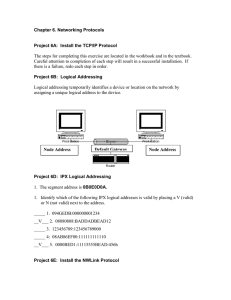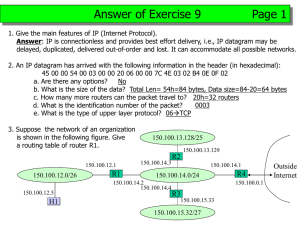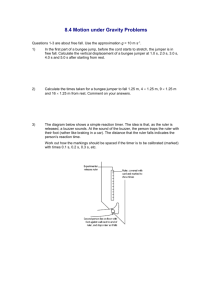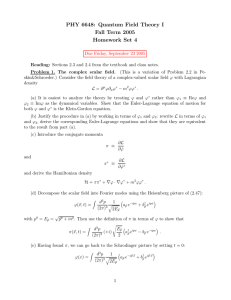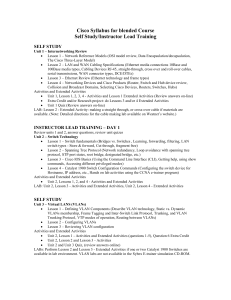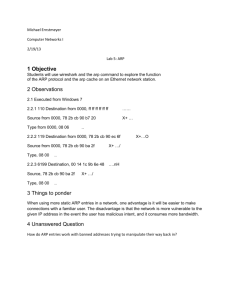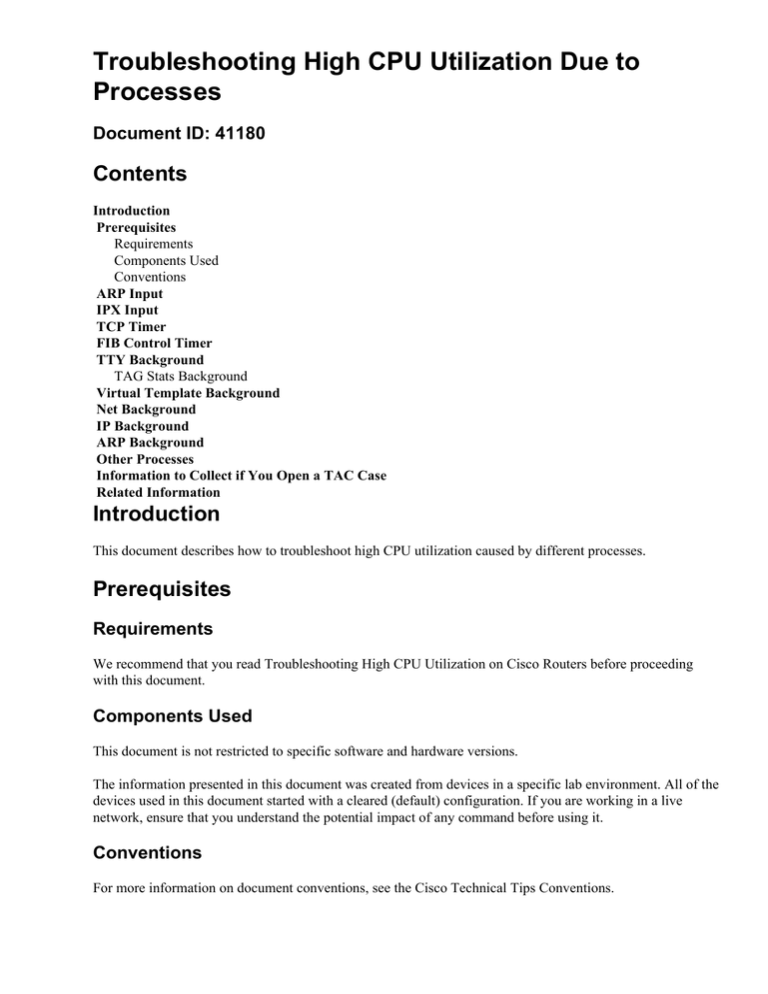
Troubleshooting High CPU Utilization Due to
Processes
Document ID: 41180
Contents
Introduction
Prerequisites
Requirements
Components Used
Conventions
ARP Input
IPX Input
TCP Timer
FIB Control Timer
TTY Background
TAG Stats Background
Virtual Template Background
Net Background
IP Background
ARP Background
Other Processes
Information to Collect if You Open a TAC Case
Related Information
Introduction
This document describes how to troubleshoot high CPU utilization caused by different processes.
Prerequisites
Requirements
We recommend that you read Troubleshooting High CPU Utilization on Cisco Routers before proceeding
with this document.
Components Used
This document is not restricted to specific software and hardware versions.
The information presented in this document was created from devices in a specific lab environment. All of the
devices used in this document started with a cleared (default) configuration. If you are working in a live
network, ensure that you understand the potential impact of any command before using it.
Conventions
For more information on document conventions, see the Cisco Technical Tips Conventions.
ARP Input
High CPU utilization in the Address Resolution Protocol (ARP) Input process occurs if the router has to
originate an excessive number of ARP requests. The router uses ARP for all hosts, not just those on the local
subnet, and ARP requests are sent out as broadcasts, which causes more CPU utilization on every host in the
network. ARP requests for the same IP address are rate−limited to one request every two seconds, so an
excessive number of ARP requests would have to originate for different IP addresses. This can happen if an IP
route has been configured pointing to a broadcast interface. A most obvious example is a default route such
as:
ip route 0.0.0.0 0.0.0.0 Fastethernet0/0
In this case, the router generates an ARP request for each IP address that is not reachable through more
specific routes, which practically means that the router generates an ARP request for almost every address on
the Internet. For more information about configuring next hop address for static routing, see Specifying a Next
Hop IP Address for Static Routes.
Alternatively, an excessive amount of ARP requests can be caused by a malicious traffic stream which scans
through locally attached subnets. An indication of such a stream would be the presence of a very high number
of incomplete ARP entries in the ARP table. Since incoming IP packets that would trigger ARP requests
would have to be processed, troubleshooting this problem would essentially be the same as troubleshooting
high CPU utilization in the IP Input process.
IPX Input
The IPX Input process is similar to the IP Input process in the sense that it takes care of process switching,
except that the IPX Input process switches IPX packets. Nearly all IPX packets are at process level looked at
by IPX Input before getting queued to other IPX processes such as IPX SAP In, IPX RIP In, and so on. Unlike
IP, IPX supports only one interrupt switching mode, and that is IPX fast−switching which is enabled by
default. IPX fast−switching is enabled using the ipx route−cache interface command .
If you see high CPU utilization during the IPX Input process, verify the following:
• IPX fast−switching is disabled. Use the show ipx interface command if IPX fast−switching is
disabled.
• Some IPX traffic cannot be IPX fast−switched:
♦ IPX broadcasts − Check if the router is overwhelmed with IPX broadcasts using the show ipx
traffic command.
♦ IPX routing updates − If there are a lot of instabilities in the network, routing update
processing increases.
Note: Instead of IPX RIP, use IPX EIGRP (incremental) to reduce the amount of updates, especially over
slow speed serial links (see Routing Novell IPX Over Slow Serial Lines and SAP Management for details).
Note: More IPX−related documents can be found at the Novell IPX Technology Support Page.
TCP Timer
When the Transmission Control Protocol (TCP) timer process uses a lot of CPU resources, this indicates that
there are too many TCP connection endpoints. This can happen in data−link switching (DLSw) environments
with many peers, or in other environments where many TCP sessions are simultaneously opened on the router.
FIB Control Timer
The FIB control timer initializes and starts the FIB statistics collection−timer for per−VLAN statistics and
global statistics; initializes and starts the FIB/ADJ request/exception timer; maintains the FIB−related registry
functions; and initializes BGP accounting timer. These processes get started when EARL is initialized.
TTY Background
The TTY Background process is a generic process used by all terminal lines (console, aux, async, and so on).
Normally there should not be any impact on the performance of the router since this process has a lower
priority compared to the other processes that need to be scheduled by the Cisco IOS software.
If this process takes high CPU utilization, check whether "logging synchronous" is configured under "line con
0." The possible cause could be Cisco bug ID CSCed16920 (registered customers only) Cisco bug ID or
CSCdy01705 (registered customers only) .
TAG Stats Background
The CPU utilization seen for the "TAG Stats Background" process is expected, and it does not affect traffic
forwarding.
The TAG Stats Background is a low priority process. This process collects statistics for tags and forwards
them to the RP. It is not a function of the amount of traffic, but of the amount of work that the MPLS/LDP
control plane does. This is an expected behavior, and it does not impact traffic forwarding. This issue is
documented in the bug CSCdz32988 (registered customers only) .
Virtual Template Background
A virtual template (vtemplate) has to be cloned for each new virtual access interface whenever a new user gets
connected to the router or access server. The CPU utilization in the Vtemplate Backgr process can get
extremely high if the number of users is large. This can be avoided by configuring pre−cloning of the virtual
template. For further information, see Session Scalability Enhancements.
Net Background
The Net Background process runs whenever a buffer is required but is not available to the process or
interface. It creates the desired buffers from the main pool based on the request. Net background also manages
the memory used by each process and cleans up the freed−up memory. This process is mainly associated with
the interfaces and can consume significant CPU resources. The symptoms of high CPU are increase in
throttles, ignores, overruns, and resets on an interface.
IP Background
The IP Background process involves these procedures: the periodic aging of the ICMP redirect cache every
minute; an encapsulation type change of an interface; the move of an interface to a new state, UP and/or
DOWN; a change in the IP address of the interface; the expiration of a new dxi map; and the expiration of
dialer timers.
The IP Background process modifies the routing table in accordance with the status of the interfaces, while
the IP Background process assumes that there is a link−state change when it receives link−state change
messages. It then notifies all routing protocols to check the affected interface. If more interfaces run routing
protocols, a higher CPU utilization is caused by the IP Background process.
ARP Background
ARP background processes handle mulitple jobs and can consume high CPU utilization.
This list provides some example jobs:
1. ARP flush due to interface up/down events
2. Clearing the ARP table through the clear arp command
3. ARP input packets
4. ARP ager
Other Processes
If any other process is consuming a lot of CPU resources, and there is no indication of any problem in the
logged messages, then the problem could possibly be caused by a bug in the Cisco IOS® software. Using the
Bug Toolkit (registered customers only) , run a search for the specified process to see if any bugs have been
reported.
Information to Collect if You Open a TAC Case
If you still need assistance after following the
troubleshooting steps above and want to create a service
request with the Cisco TAC, be sure to include the following
information:
• Output from the following show commands:
♦ show processes cpu
♦ show interfaces
♦ show interfaces switching
♦ show interfaces stat
♦ show align
♦ show version
♦ show log
Related Information
• Troubleshooting High CPU Utilization on Cisco Routers
• Troubleshooting High CPU Utilization Due to the IP Input Process
• Technical Support − Cisco Systems
Contacts & Feedback | Help | Site Map
© 2014 − 2015 Cisco Systems, Inc. All rights reserved. Terms & Conditions | Privacy Statement | Cookie Policy | Trademarks of
Cisco Systems, Inc.
Updated: Sep 29, 2008
Document ID: 41180

